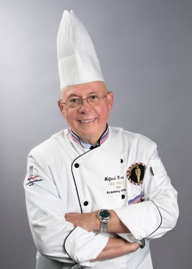West Palm Beach (Part 4):
- If you are looking for chef coats for your class, try calling your local uniform rental/cleaning company. When the coats are barely worn, they will sell for almost nothing and/or donate the coats to your class. (MM)
Preparing a rack-of-lamb dinner for two, from ACF’s 2008 Educator of the Year
By Wilfred Beriau, CEC, CCE, AAC
 Center-of-the-plate proteins, including American lamb, are the focus of this lesson plan for freshman in the Associate of Applied Science degree program at Southern Maine Community College in South Portland. The course, of which this lesson is a part, addresses the basic fabrication of meat, fish and poultry; stocks; the five major sauces; derivative sauces; coulis, jus lié, and reductions. The class covers moist and dry methods of cooking that demonstrate appropriate cooking methods for a wide array of products.
Center-of-the-plate proteins, including American lamb, are the focus of this lesson plan for freshman in the Associate of Applied Science degree program at Southern Maine Community College in South Portland. The course, of which this lesson is a part, addresses the basic fabrication of meat, fish and poultry; stocks; the five major sauces; derivative sauces; coulis, jus lié, and reductions. The class covers moist and dry methods of cooking that demonstrate appropriate cooking methods for a wide array of products.
A key component of this lesson plan involves the preparation and presentation of a NAMP/#204A domestic rack of lamb with accompaniments of a starch, a vegetable, jus lié and herb garnish.
The method is the constant, and the ingredients are the variables.
By Samuel Glass, CEC, CCE, CCA
 As the demographic of culinary schools shifts to a much more multicultural environment, embracing and celebrating cultural diversity is becoming part of the everyday life of culinary institutions. The challenge for culinary instructors is in finding a way to integrate cultural diversity into the curriculum in a tacit manner, one in which students might not recognize the true objectives, yet at the same time, achieve a sense of accomplishment and pride in their own cultural heritage and cuisine.
As the demographic of culinary schools shifts to a much more multicultural environment, embracing and celebrating cultural diversity is becoming part of the everyday life of culinary institutions. The challenge for culinary instructors is in finding a way to integrate cultural diversity into the curriculum in a tacit manner, one in which students might not recognize the true objectives, yet at the same time, achieve a sense of accomplishment and pride in their own cultural heritage and cuisine.
One of the mantras that I have always used as a culinary educator is, “The method is the constant and the ingredients are the variables.” Keeping that mantra in mind, I have found a way to celebrate the diversity of my students, while meeting the objectives of the curriculum.
A lesson plan.
By Mary Petersen and Ronald S. Wolf, CCC, CCE
This lesson plan focuses on the history of and cultural influences on Indian cuisine, the topography and climate that affect food production and preparation, key ingredients and foods, cooking methods and common equipment, a focus on culinary regions, and dietary restrictions as dictated by various religions, among other aspects. A handout as an MS Word document is available for download and copying.
By Bruce Kraig, Ph.D.
This lesson plan teaches history through American regional foodways, as influenced and reflected by geography, ecology and cultural ecology, economics, social science, anthropology and language. The lesson plan, which contains many illustrative recipes, may be downloaded as a PowerPoint presentation from this page.